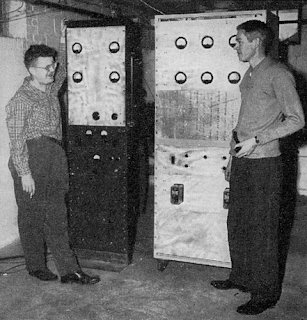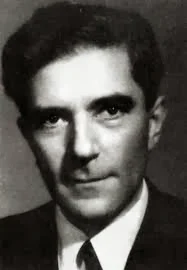Serving the worldwide community of radio-electronic homebrewers. Providing blog support to the SolderSmoke podcast: http://soldersmoke.com
Podcasting since 2005! Listen to our latest pocast here:
Podcasting since 2005! Listen to Latest SolderSmoke
Wednesday, November 13, 2013
BITX Build Update #19 Layout, VXO, Bal Mod, Filter, PA
The files of the BITX20 Yahoo group were very useful to me during my BITX build. So I have decided to make a contribution myself. I uploaded a few drawings today. Here is how I laid out the circuitry on my 8 inch by 11 inch copper clad board. I included the isolation (Manhattan) pads for one of the bidirectional amps.
Here is the VXO. I built is on a separate board, but I could have put it on the main board.
Here is the balanced modulator and crystal filter.
Here is the power amplifier circuitry. Amazingly easy to stabilize.
Our book: "SolderSmoke -- Global Adventures in Wireless Electronics" http://soldersmoke.com/book.htm Our coffee mugs, T-Shirts, bumper stickers: http://www.cafepress.com/SolderSmoke Our Book Store: http://astore.amazon.com/contracross-20
BITX (and W2AEW) on Hack-A-Day
The guys over on Hack-A-Day ran a little follow-up article on the BITX-17. Check it out:
http://hackaday.com/2013/11/13/bitx-a-return-to-hackers-paradise/#comments
They also had an article about Tek-Wizard Alan Wolke earlier in the week:
http://hackaday.com/2013/11/11/diagnose-and-repair-a-yaesu-ft-7800-ham-radio/
Our book: "SolderSmoke -- Global Adventures in Wireless Electronics" http://soldersmoke.com/book.htm Our coffee mugs, T-Shirts, bumper stickers: http://www.cafepress.com/SolderSmoke Our Book Store: http://astore.amazon.com/contracross-20
New Book About Heathkit Gear
Jeff Tranter, VE3ICH, has a new book out -- it is about Heathkit Test Gear. (Hey, I had that VTVM on the cover!) This book looks like it deserves a place under the Christmas trees of SolderSmoke fans. The book is available from Lulu.com, and Santa (or Mrs. Claus) can use the discount coupon below (Coupon code: CORNUCOPIA.)
http://www.lulu.com/shop/jeff-tranter/classic-heathkit-electronic-test-equipment/paperback/product-21272772.html
Our book: "SolderSmoke -- Global Adventures in Wireless Electronics" http://soldersmoke.com/book.htm Our coffee mugs, T-Shirts, bumper stickers: http://www.cafepress.com/SolderSmoke Our Book Store: http://astore.amazon.com/contracross-20
Tuesday, November 12, 2013
Save 20% on SolderSmoke and other Lulu books (through Nov 15)
http://www.lulu.com/spotlight/soldersmoke
Our book: "SolderSmoke -- Global Adventures in Wireless Electronics" http://soldersmoke.com/book.htm Our coffee mugs, T-Shirts, bumper stickers: http://www.cafepress.com/SolderSmoke Our Book Store: http://astore.amazon.com/contracross-20
Saturday, November 9, 2013
That wonderful first contact, when the new HB rig is still on the workbench...
In this video, YC0AFF in Indonesia seems to be having as much fun with his new BITX as I've been having with mine. I think there is something special about those early contacts, when the newly finished (or not quite finished!) rig is still on the workbench. Designed in India and built by radio amateurs all around the world, the BITX has become a global ham radio phenomenon, reminding us that we form an International Brotherhood of Electronic Wizards.
Our book: "SolderSmoke -- Global Adventures in Wireless Electronics" http://soldersmoke.com/book.htm Our coffee mugs, T-Shirts, bumper stickers: http://www.cafepress.com/SolderSmoke Our Book Store: http://astore.amazon.com/contracross-20
An Amazing French Workshop (Video)
Our book: "SolderSmoke -- Global Adventures in Wireless Electronics" http://soldersmoke.com/book.htm Our coffee mugs, T-Shirts, bumper stickers: http://www.cafepress.com/SolderSmoke Our Book Store: http://astore.amazon.com/contracross-20
Friday, November 8, 2013
Knack-to-the-Max! Early Moonbounce
The link below will take you to an amazing collection of QST articles describing the early days of EME or "moonbounce." Very interesting. I was really blown away when I found out that Ross Bateman, W4AO, (pictured above, on the left) did the very first amateur moonbounce work from the small suburban Washington town that I live in now -- Falls Church, Virginia!
I am trying to find OM Ross's old address or more info about him. If anyone has an old callbook, could you please look up Ross Bateman, W4AO, aka W4XNB? He worked at the National Bureau of Standards.
The moonbounce story is filled with interesting technology and characters and clubs. Sam Harris and his Rhododendron Swamp VHF Society sounds like our kind of group! Scroll through the OK2KKW web site and you will come across our esteemed Doug DeMaw and Bill Orr.
http://www.ok2kkw.com/eme1960/eme1960eng.htm
Our book: "SolderSmoke -- Global Adventures in Wireless Electronics" http://soldersmoke.com/book.htm Our coffee mugs, T-Shirts, bumper stickers: http://www.cafepress.com/SolderSmoke Our Book Store: http://astore.amazon.com/contracross-20
Wednesday, November 6, 2013
Zoltan Bay and his Chemical Moonbounce Detector
In March 1944, Bay recommended using the radar for scientific experimentation, including the detection of radar waves bounced off the Moon. The scientific interest in the experiment arose from the opportunity to test the theoretical notion that short wavelength radio waves could pass through the ionosphere without considerable absorption or reflection. Bay's calculations, however, showed that the equipment would be incapable of detecting the signals, since they would be significantly below the receiver's noise level.
The critical difference between the American and Hungarian apparatus was frequency stability, which DeWitt achieved through crystal control in both the transmitter and receiver. Without frequency stability, Bay had to find a means of accommodating the frequency drifts of the transmitter and receiver and the resulting inferior signal-to-noise ratio. He chose to boost the signal-to-noise ratio. His solution was both ingenious and far-reaching in its impact.
Bay devised a process he called cumulation, which is known today as integration. His integrating device consisted of ten coulometers, in which electric currents broke down a watery solution and released hydrogen gas. The amount of gas released was directly proportional to the quantity of electric current. The coulometers were connected to the output of the radar receiver through a rotating switch. The radar echoes were expected [11] to return from the Moon in less than three seconds, so the rotating switch made a sweep of the ten coulometers every three seconds. The release of hydrogen gas left a record of both the echo signal and the receiver noise. As the number of signal echoes and sweeps of the coulometers added up, the signal-to-noise ratio improved. By increasing the total number of signal echoes, Bay believed that any signal could be raised above noise level and made observable, regardless of its amplitude and the value of the signal-to-noise ratio.26 Because the signal echoes have a more-or-less fixed structure, and the noise varies from pulse to pulse, echoes add up faster than noise. From: http://history.nasa.gov/SP-4218/ch1.htm
During the war, Zoltán Bay protected Jewish colleagues from Nazi persecution. In 1998, the State of Israel honored him as Righteous Among the Nations for his actions and listed his name at Yad Vashem.
Our book: "SolderSmoke -- Global Adventures in Wireless Electronics" http://soldersmoke.com/book.htm Our coffee mugs, T-Shirts, bumper stickers: http://www.cafepress.com/SolderSmoke Our Book Store: http://astore.amazon.com/contracross-20
Monday, November 4, 2013
SolderSmoke Podcast #156 -- Special Echolink Interview
http://soldersmoke.com/soldersmoke156.mp3
Special hour-long interview with Peter Parker, VK3YE
-- Early experiences with radio
-- CW
-- DSB Gear
-- Simple gear, and gear that is TOO simple
-- VXOs, Super VXOs and Ceramic Resonators
-- Building receivers
-- Chips vs. Discrete
-- Making the leap to SSB
-- The Knob-less wonder and the BITX
-- No need for a sophisticated workshop
-- Advice for new phone QRPers
Our book: "SolderSmoke -- Global Adventures in Wireless Electronics" http://soldersmoke.com/book.htm Our coffee mugs, T-Shirts, bumper stickers: http://www.cafepress.com/SolderSmoke Our Book Store: http://astore.amazon.com/contracross-20
Sunday, November 3, 2013
BITX Build Update #18 -- BITX in a Box?
I've really been enjoying using my BITX17 without an enclosure. Having all the electronics exposed on the workbench really accentuated the homebrew nature of this rig. But obviously it was time to box this thing up. At a local craft store, I found a wooden box that is exactly the right size for my BITX copper clad board. I put the BITX in the box yesterday. I kind of miss the exposed electronics.
The far left control is AF gain. The need for a few inches of wire to the pot has introduced a bit of AC hum. I'll try to knock this down with better shielding on the lead to the pot.
But this gets brings us too a bigger question: the need for a cabinet that shields. Obviously the wood shields it only from dust. I know there are some benefits to putting this thing in a proper metal box. The AC hum would be less of a problem. Also -- listen to this -- in the morning, before 17 opens, I can hear -- faintly -- the WWV transmission on 5 MHz (recall that the IF in this rig is 5 MHz). And if I ever build an external linear amp for this rig (I might), I guess a proper metal box would help prevent the kind of oscillation that often drives me crazy on these kinds of projects.
So, what do you guys think? Stick with the wood, or put it in a metal box? Any thoughts on putting metal shielding material around the inside of the box (thick aluminum of tin foil)?
(The other black control knob is for a rotary switch that will allow me to select among two or three crystals for the VXO. )
Our book: "SolderSmoke -- Global Adventures in Wireless Electronics" http://soldersmoke.com/book.htm Our coffee mugs, T-Shirts, bumper stickers: http://www.cafepress.com/SolderSmoke Our Book Store: http://astore.amazon.com/contracross-20
Saturday, November 2, 2013
40% Off SolderSmoke Book!!! Through 4 November
And on all Lulu books.
Just use the coupon code FALLSALE40 at checkout.
http://www.lulu.com/spotlight/soldersmoke
Our book: "SolderSmoke -- Global Adventures in Wireless Electronics" http://soldersmoke.com/book.htm Our coffee mugs, T-Shirts, bumper stickers: http://www.cafepress.com/SolderSmoke Our Book Store: http://astore.amazon.com/contracross-20
Just use the coupon code FALLSALE40 at checkout.
http://www.lulu.com/spotlight/soldersmoke
Our book: "SolderSmoke -- Global Adventures in Wireless Electronics" http://soldersmoke.com/book.htm Our coffee mugs, T-Shirts, bumper stickers: http://www.cafepress.com/SolderSmoke Our Book Store: http://astore.amazon.com/contracross-20
Arecibo Birthday
Thanks to Bob Crane for this birthday alert:
The
Arecibo Observatory opened on this date in 1963. At a diameter of
a thousand feet, it's the largest single-aperture telescope ever built. It's
also got the largest focusing dish in the world, which gathers electromagnetic
waves from space. Located near the city of Arecibo in Puerto Rico, it's close to
the equator, which enables it to "see" (via radio waves) all the planets in the
solar system; within six months of its opening, it enabled scientists to study
the rotation rate of Mercury and determine that it rotated every 59 days, rather
than 88 as was previously thought. It's also been used for military purposes
like locating Soviet radar installations by tracking their signals as they were
reflected off the moon. It's provided the first full imaging of an asteroid and
also led to the first discovery of planets outside our solar system.
In 1999, it began collecting data for the SETI
Institute; SETI stands for "search for extraterrestrial intelligence," and the
organization looks for deliberate radio or optical signals from other planets.
The Arecibo Observatory also sends data over broadband to the home and office
computers of 250,000 volunteers, who, through the Einstein@Home program, donate
their computers to be used for data analysis during periods when they would
otherwise be idle. A year ago, three such volunteers in Iowa and Germany
discovered a previously unknown pulsar, 17,000 light years from
Earth.
Our book: "SolderSmoke -- Global Adventures in Wireless Electronics" http://soldersmoke.com/book.htm Our coffee mugs, T-Shirts, bumper stickers: http://www.cafepress.com/SolderSmoke Our Book Store: http://astore.amazon.com/contracross-20
Subscribe to:
Comments (Atom)











